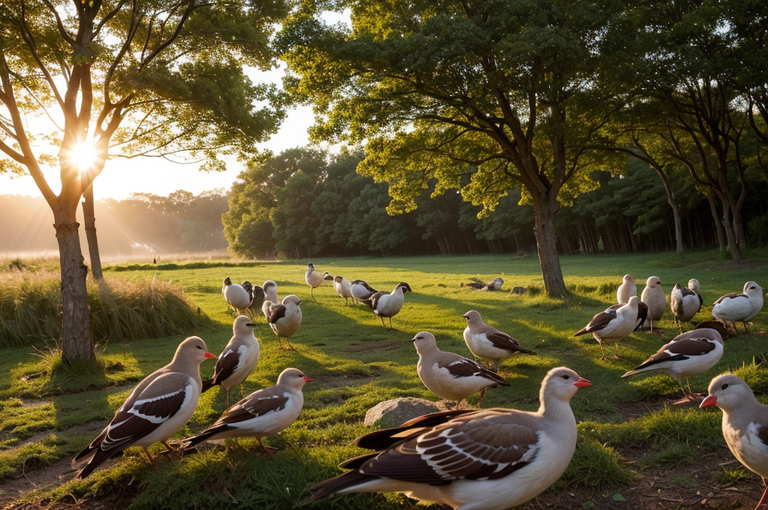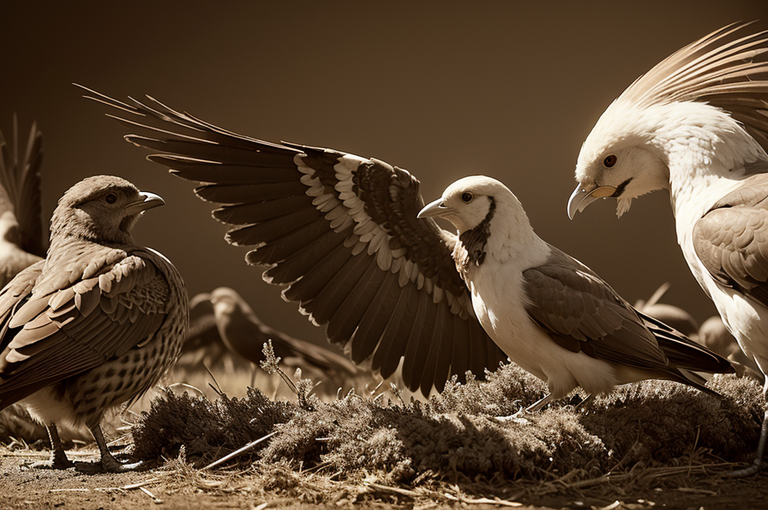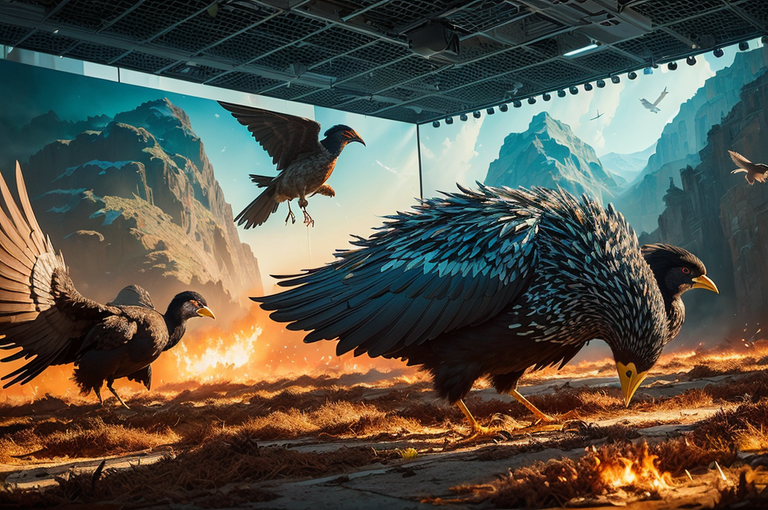Understanding the Impacts and Implications of Feeding Wild Birds

The article discusses the ecological impacts of feeding wild birds, including changes in species interactions and migratory patterns. It also explores bird-feeding best practices, the benefit of creating natural habitats, and the potential conflicts with other wildlife.
Introduction to Bird Feeding
Ah, bird feeding! The unique practice of providing supplemental nourishment to our wild feathered friends. There are few better ways to get acquainted with the abundant birdlife that grace our surroundings. 🐦
Definition of Bird Feeding
Bird feeding essentially involves the supplemental feeding of wild birds. In other words it’s a practice to provide food to birds in their natural environment, and this can range from strewing breadcrumbs to offering the finest assortment of seeds. Speaking of the latter, I must say, nothing quite beats the best wild bird seed when it comes to attracting a diverse crowd of cheerful chirpers!
Popularity of Bird Feeding
Over the years, bird feeding has become increasingly popular. It’s a testament to our enduring fascination with these winged marvels and an expression of our desire to better understand our avian counterparts. I’ve watched with glee the camaraderie bird feeding brings the thrill of spotting a new species, the satisfaction of nurturing nature’s flyers, and the gentle education it provides.
Ecological Impacts of Bird Feeding
Yet as we indulge in this practice, it behooves us to think of the potential ecological impacts. My research and observation suggest that supplemental feeding can alter bird species interactions, even potentially affecting migratory patterns. But before I take you deeper into this topic, let me just say it’s the little actions we take that can echo marvelously through the intricate web of nature.
So whether you’re an experienced bird watcher or a fellow nature enthusiast who enjoys the symphonies of bird songs, let’s journey together into the vibrant world of bird feeding. Get ready to be enchanted by the feathery wonders that await us. 🐦🌾+

Insights into Various Species, Food, and Feeder Preferences
I delight at the sight of the varied beautiful creatures that come to perch on my feeder, each with their particular tastes. No two species share the same palette, and that, my friends, is the charm of our feathered friends. Cardinals have a keen liking for black oil sunflower seeds and safflower. Blue Jays love peanuts and hate nyjer. Finches, on the other hand? They can’t resist the lure of the nyjer, oddly enough! The diversity of food preferences of these breathtaking avians is truly striking.
Explanation of Species-Specific Food Preferences
Indeed, if one were to delve into the matter, one could liken them to connoisseurs, each seeking out the best seeds for wild birds according to their uniquely refined palate. Take the Evening Grosbeak, for example. Sunflower seeds win its favor, while Pine Siskins opt for a fuel rich diet of seeds, buds, and berries.
Overview of Different Types of Feeders for Attracting Specific Species
The vast array of feeders available today caters to these individual leanings. For large birds like the Grosbeak, tray feeders are excellent. Tube feeders with tiny holes are particularly enticing for the minuscule beaks of finches. For woodpeckers, suet feeders are the ideal dining spot.
Introduction to The Role of These Preferences in the Diversity of Bird Species
The fascinating link between feeding habits and the species diversity is truly worth considering. Customizing food items and tactics, especially in the frost covered winters, helps draw distinct bird species into the yard. With every new bird attracted, local biodiversity spikes up, painting a richer, more vibrant picture of avian life around us. Truly, attracting and feeding wild birds is an art, a subtle dance of lure and satisfaction that keeps the heart of nature beating, and keeps our eyes alight with wonder and delight.
Every backyard can become a sanctuary for these flying wonders, a gathering spot for the diverse richness of avian culture. We just need to understand their tastes and cater to them. And in doing so, we not only attract beauty to our own lives but grant these magnificent creatures a safe haven in an increasingly dangerous world. After all, our feathered friends are not just birds they’re living, breathing testaments of the captivating grandeur and diversity of Mother Nature.

Potential Negative Impacts of Bird Feeding
While discussing the enchanting ritual of how to feed wild birds, it’s essential to also observe the potential shadows it may cast upon the vivid canvas of avian life.
Alteration of Migratory Behaviors
One such aspect has to do with the potential alteration in migratory patterns of birds. Feeding can sometimes play tricks on a bird’s innate intuition, causing it to linger away from its migratory time clock. Enthralling as it may seem to keep these feathered songsters around, it’s essential to appreciate their natural course of journey, unaltered by human intervention.
Disease Transmission among Birds
Equally concerning can be the issue of disease transmission. Unsanitary feeding practices can become unwelcome dinner venues where illnesses spread like wildfire among birds, a grim prospect no bird lover would fancy! Herein lies the paradox: while the intent behind feeding these wild winged marvels is often to offer support, we may unintentionally be introducing health hazards.
Conflicts with other Wildlife
Lastly, well intended bird feeders can sometimes provoke unwanted conflict with other wildlife. Imagine, for instance, the majestic yet rather unwelcome sight of a black bear, drawn by the scent of your offerings. It’s a reminder that our efforts to aid bird life should also maintain harmony with the broader tapestry of nature at large.
To hold an arm outstretched with seeds for the soaring swans or chirping chickadees is to participate in an act of love. However, let this love be well guided, aware of its potential ties with altering the rhythms of mother nature.

Best Feeding Practices and Alternative Approaches
A heartbeat quickens, the chill in the air is biting. As I unfurl my fist and scatter seeds, the spectral hush is broken by a flock of chickadees racing to swoop down. You see, seasonal feeding, especially during the frigid winters, is a line of duty I fervently uphold. Bird watchers, take a cue it’s essential to heed season specific advice. Hence, be careful not to feed birds during warmer months when natural resources are aplenty, so they don’t end up relying on human hand outs. Remember, balance is the key. Also, barely noticeable in the winters, grab this wild bird discount code if you need some supplies.
Insights into Seasonal Feed
Don’t you get a twinge of satisfaction when you chance upon a red cardinal amidst a white winter blanket? I certainly do. It’s a sign they’ve managed to survive the worst nature could conjure. Leading my rosy cheeks to coo ’thank bird feed’. Well, don’t let this winter camaraderie lull you into thinking that feeding is a year long spectacle. Overfeeding disrupts their natural diet and makes them dependent. So, keep pace with nature’s clock.
Creating Natural Habitats in Backyards
Eying the red oak in my backyard, I feel a sense of serenity. More so because I know underneath its sprawling canopy of leaves lay hidden, clusters of acorns sustenance for my feathered friends. Having native plants, providing a year round food source, is crucial for the birds we cherish so much.
Strategies to Improve Bird Health
As I embarked on this fulfilling journey, I realized when the feeding practices we adhere to are responsible, it enhances bird immune responses and promotes health. Honestly, there’s nothing more rewarding than watching a vibrant bird spread its wings against the bright azure sky; healthy, hail, and hearty.
In essence, bird feeding is a complex ballet, requiring finesse and knowledge. We must take heed not to disrupt Mother Nature’s course, while we seek to lend a gentle hand to our avian companions. After all, we are but guests in their world, privileged to witness their magic.
The Connection to Nature through Bird Feeding
Feeding our feathered friends brings something invaluable to our connections – an intimate bond with nature itself. The steady preparation and dissemination of the best wild bird seed has shown me how deeply entwined our world is with theirs.
Connecting through Feeding
There’s a joy in acknowledging the simplicity, yet profundity, of this act. With every morsel, we are not merely nourishing wild birds, but also strengthening humanity’s connection to the natural world. Every bird feeding station built and every wild bird discount code utilized, echoes our shared responsibility towards these creatures and the habitats they represent.
Personal Satisfaction and Learning
There’s something deeply personal, satisfying even, in creating bird friendly spaces and watching them burst into life with diverse avian species drawn to the best seeds for wild birds. Just the sight of a tufted titmouse or a flock of goldfinches is enough to ignite a sense of joy and fascination within me.
Educational Value of Bird Feeding
The ritual of bird feeding is more than just a pastime – it’s an informative conduit through which both adults and children can gain a newfound appreciation for nature’s diversity. It fosters a sense of curiosity as we watch them feed and interact, opening our eyes to different bird species and their behaviours.
The practice goes beyond merely offering food; it’s a testament to co existence. Putting out the best wild bird seed on your property and watching the show unfold has proven to me the worth of patience, observation and empathy, all wrapped into one fulfilling lesson. I can’t think of a better way to learn about these enchanting creatures than how to feed wild birds a practice that enriches all who are involved.
Much like a red cardinal on a snowy day, this vibrant interaction adds a dash of color to our lives, making us feel a little closer to the magic of nature. The charm of bird feeding is that it gives as much as it takes, creating a cycle of giving and receiving that perpetuates the magic of nature in our daily lives.


